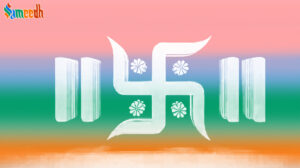Drawing a swastik in Hinduism is a sacred and symbolic practice, and there are traditional ways to draw it to ensure its positive and auspicious connotations. Here are general guidelines for drawing a swastik in Hindu tradition:

- Orientation: The swastik should typically be drawn with the arms bent at right angles and facing to the right. This is the traditional and auspicious orientation in Hinduism. The right-facing swastik is associated with positive energy and well-being.
- Equal Arms: Ensure that all arms of the swastika are of equal length. Symmetry is an essential aspect of the swastik’s symbolism, representing balance and harmony.
- Direction of Drawing: Traditionally, when drawing a swastik, it is considered auspicious to start from the center and move outward. This signifies the expansion of positive energy from a central source.
- Intention and Devotion: While drawing the swastik, maintain a sense of reverence and devotion. Focus on positive thoughts and intentions, seeking blessings and well-being for yourself and others.
- Place of Drawing: The swastik is often drawn at the entrance of homes, temples, and during religious ceremonies. Drawing it in these sacred spaces is believed to enhance positive energies and invoke divine blessings.
- Clean and Clear Lines: Draw the swastik with clear and clean lines. A well-drawn and well-defined swastik is considered more effective in conveying positive energy.
It’s important to note that the swastik‘s symbolism can vary across different cultural and regional traditions within Hinduism. Additionally, while the swastik is a sacred symbol in Hinduism, its associations have been complicated by its misuse during the 20th century. Therefore, cultural sensitivity is crucial when using or displaying the swastika, especially in global contexts.
If you are participating in religious rituals or cultural practices, it’s recommended to follow the specific traditions and guidelines of your community or the religious context in which you are involved.
